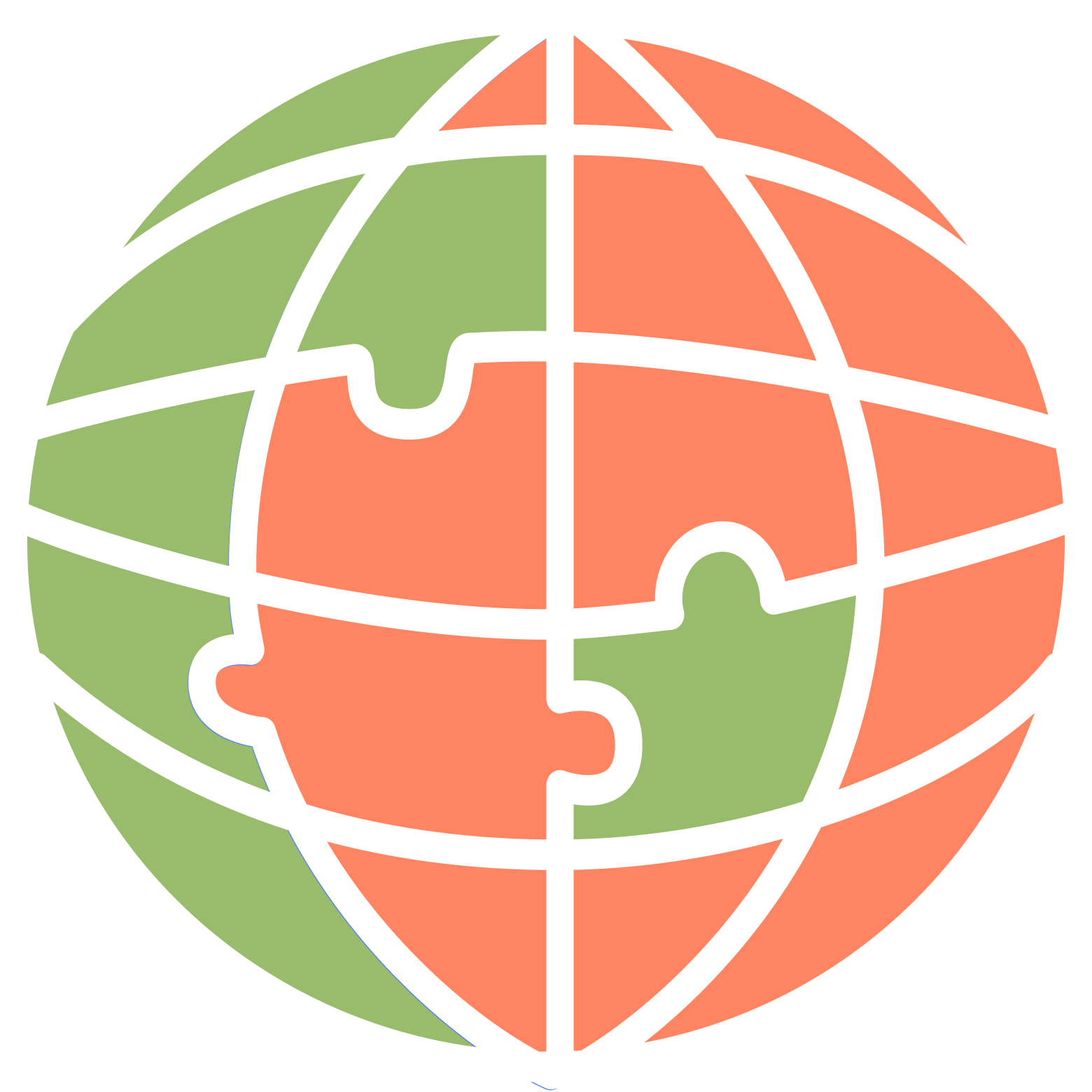Objective:
To draw participants' attention to how they choose information sources and discuss criteria for media reliability.
- Number of participants:2 to 25
- Age range:12+
- Duration:45 minutes
How to conduct:
Hand out diagrams to participants and explain: "The figure in the center represents you. Surrounding you are various media that offer different content (news, series, talk shows, music, TV and radio shows, etc.)."

Then, give the following instructions: "Take 10 minutes to think about your typical day and the types of media you use, the type of content you choose, and the amount of time you allocate to different media. In the empty cells, you can mention additional content not accounted for in the table. In the cells under 'time,' mark how many hours you spend on each media resource daily."
Invite participants to review the results in a group discussion and answer the following questions:
- Do you think your media environment addresses important questions in your life? Why?
- Would you like to change your approach to consuming information? How?
Together with the participants, create a list of recommendations on how to approach choosing sources.
If the participants find it difficult to make specific recommendations, use the information verification algorithm.
Objective:
To teach participants to distinguish between facts and opinions.
- Number of participants:2 to 25
- Age range:10+
- Duration:15-20 minutes
How to conduct:
This exercise can be used for both individual and group work. Prepare texts that contain both facts and opinions: interviews, news, feature articles, etc.
At the beginning of the session, ask participants about the difference between an opinion and a fact. If necessary, provide the following definitions and examples:
Fact: A statement that can be verified and confirmed using objective data or sources.
Example: "There are fewer job openings for entry-level IT specialists this year compared to 2022."
Opinion: A statement that expresses the author's personal attitude or evaluation.
Example: "No one needs entry-level IT specialists; only those with experience get hired."
Instructions for participants:
This exercise can be used with children and teenagers. In this case, it may be necessary to adapt the texts or use short statements for analysis.
Fact: A statement that can be verified and confirmed using objective data or sources.
Example: "There are fewer job openings for entry-level IT specialists this year compared to 2022."
Opinion: A statement that expresses the author's personal attitude or evaluation.
Example: "No one needs entry-level IT specialists; only those with experience get hired."
Instructions for participants:
- Read the text or statement to be analyzed.
- Identify all the statements contained in the text.
- For each statement, determine whether it is a fact or an opinion.
- Mark all facts and opinions in the text using different colors or symbols.
- Create a list of facts and opinions.
This exercise can be used with children and teenagers. In this case, it may be necessary to adapt the texts or use short statements for analysis.
Objective:
To teach participants to distinguish between facts and opinions.
- Number of participants:2 to 30
- Age range:16+
- Duration:15-20 minutes
How to conduct:
This exercise can be used as a lead-in to the topic "Fact/Interpretation" or one of the sessions on this topic. It's best not to announce the topic in advance.
Ask participants to watch a video with a mysterious plot or a metaphor. Choose a video no longer than 2–3 minutes. You could use an excerpt from "The Tale of Tales" (10:05 – 11:30) or find another 2–3 minute video.
Ask participants to watch a video with a mysterious plot or a metaphor. Choose a video no longer than 2–3 minutes. You could use an excerpt from "The Tale of Tales" (10:05 – 11:30) or find another 2–3 minute video.
Ask the question:
"What is happening in this video?"
Invite the group to share their thoughts. Record participants’ on a flipchart or slide. The diversity of interpretations is beneficial here.
Then, draw participants' attention to your question ("What is happening in this video?"). Explain the difference between an interpretation ("I think what is happening is...") and a fact ("What is happening is...").
Ask participants to review your notes of their versions and answers. Together, analyze which statements are facts and which are interpretations (opinions).
You can then show the video again and ask participants to state only the facts.
To conclude the exercise, you can discuss the following questions:
This exercise can be done in groups or individually. Depending on the chosen format, you can ask participants to write down their observations or discuss them, then note what was a fact and what was an interpretation.
"What is happening in this video?"
Invite the group to share their thoughts. Record participants’ on a flipchart or slide. The diversity of interpretations is beneficial here.
Then, draw participants' attention to your question ("What is happening in this video?"). Explain the difference between an interpretation ("I think what is happening is...") and a fact ("What is happening is...").
Ask participants to review your notes of their versions and answers. Together, analyze which statements are facts and which are interpretations (opinions).
You can then show the video again and ask participants to state only the facts.
To conclude the exercise, you can discuss the following questions:
- When are facts appropriate, and when are interpretations appropriate?
- Is it difficult to remain an observer and not judge what is happening?
- Which system was at work in each case? (Refer to the theory of "Thinking, Fast and Slow")
- What can be done to avoid interpretations?
- What is non-judgmentalism, and where and how can it be applied?
- How can the experience of this exercise help you to work with information in the future?
This exercise can be done in groups or individually. Depending on the chosen format, you can ask participants to write down their observations or discuss them, then note what was a fact and what was an interpretation.
Objective:
To teach participants to work with information systematically and see the connection between observation (information gathering), interpretation (analysis of gathered information), and subsequent inquiry (asking questions).
- Number of participants:5 to 25
- Age range:10+
- Duration:15-45 minutes
How to conduct:
“See.Think.Wonder” is suitable for sessions that require distinguishing facts from interpretation and include inquiry. This exercise demonstrates two stages of thinking that our brain often performs automatically using System 1: observation and interpretation. Our goal is to activate System 2 by separating these stages, analyzing them, and adding a third stage: inquiry (asking questions).
- Choose an object for the inquiry. This could be a piece of visual art, such as a painting, sculpture, building, or piece of furniture; a poem or literary text; a film excerpt; or even a view from a window.
- Provide participants with a chart with three columns labeled "See," "Think," and "Wonder," or ask them to draw it themselves.
Instructions for participants:
After the exercise, allocate time for reflection.
You can use the following questions:
Note:
Allocate 3 to 10 minutes for each stage of working with the table, depending on the object, group, and goals. This can be a quick skill-building exercise or an in-depth analysis of the object including the discussion of each stage.
Variation:
This exercise is versatile and applicable to various topics and subjects. Its regular use with different objects promotes the fundamentals of critical thinking: observation, interpretation, and questioning. It can be the main exercise of a session with discussions at each stage. Alternatively, it can be a quick group exercise with the facilitator only noting the group's observations.
- Introduce the chosen object to participants and allow them to study it for two minutes (if it's an excerpt from a literary work or film, the time can be increased).
- Ask participants to record their observations in the first column, "See." Emphasize that they should first note the facts (what they actually see).
- Then ask participants to write in the second column, "Think," what they think about what they have observed, and what their observations suggest. Highlight that it is important here to interpret what was recorded in the first column.
- Finally, ask participants to note what surprises them and what they want to learn about the object in the third column, "Wonder." Emphasize that at this stage, they should identify what interests them personally and note what they still don't know and want to find out.
After the exercise, allocate time for reflection.
You can use the following questions:
- Which observations seemed most interesting or significant to you? Why?
- What is the difference between your initial expectations of the object and your final impressions after completing the exercise?
- What new ideas or thoughts did you gain from analyzing the object?
- What did you learn about yourself and your thought processes during this exercise?
- What difficulties did you encounter in the process of analyzing and interpreting the object? How did you overcome them?
- What questions do you still have after completing the exercise? What would you like to study or learn more about?
- How can you apply the knowledge or skills gained in your daily life or studies?
Note:
Allocate 3 to 10 minutes for each stage of working with the table, depending on the object, group, and goals. This can be a quick skill-building exercise or an in-depth analysis of the object including the discussion of each stage.
Variation:
This exercise is versatile and applicable to various topics and subjects. Its regular use with different objects promotes the fundamentals of critical thinking: observation, interpretation, and questioning. It can be the main exercise of a session with discussions at each stage. Alternatively, it can be a quick group exercise with the facilitator only noting the group's observations.
Example:
How to use the exercise in an art lesson
How to use the exercise in an art lesson
- Show students a painting (or another art object) and mention the artist, but not the title. Ask students to look at the painting and fill in the first column.
- Then ask them to respond to the questions in the second and third columns.
- Afterward, delve deeper into the subject and discuss the artwork with the group based on the facts and observations they noted down. Here, you can mention what the critics say about the painting and see whether students had similar ideas.

Vasily Vereshchagin




